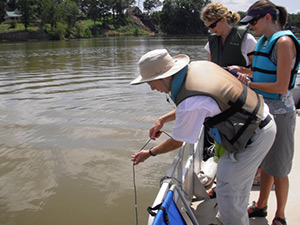
A scientific and environmental examination of Lake Greenwood was undertaken recently by a team that included Dr. Austin Trousdale, assistant professor of biology at Lander University, and staff from Upstate Forever, the natural resource conservation group. The purpose of their study was to learn more about the lake.
Trousdale recalled that, over the past 15 years, public agencies, environmental advocacy groups, lakeside property owners and others have expressed concern for the health of the lake's ecosystem. He said, "Loss of surface area due to sedimentation, or filling in, has been documented in the reservoir's upper reaches."
He also pointed out the lake's vulnerability to phosphate pollution as demonstrated by the dramatic growth of algae, most seriously during the summer of 1999. He said scientific studies reveal that algae reduces the amount of oxygen available to fish and beneficial invertebrates in Lake Greenwood and many other inland bodies of water.
According to research, lawn and garden fertilizers are often a major source of phosphate pollution, especially during periods of soil erosion. And when those substances are overspread onto hard surfaces such as roadways, rain washes them into storm drains which empty into rivers and lakes.
After touring the lake's hydroelectric facility at Buzzards Roost, the team spent the remainder of the day aboard Lander's research vessel,the 30-foot pontoon boat Asterionella. They anchored just above the confluence of the Saluda and Reedy Rivers where they took measurements including water temperature, level of dissolved oxygen, acidity and depth of incoming light. They repeated the measurements at a site four miles downstream
Trousdale said measurements confirmed that the stratification of the water column, a typical summer feature of Lake Greenwood, had broken down most likely as a result of strong thunderstorms several days earlier. The group theorized the lake will probably restratify before giving way to an extended period of isothermal conditions as seasons change from fall to winter.
Trousdale said the trip successfully collected useful environmental data. He added that it resulted in further bridge-building between Lander and Upstate Forever, and gave him an opportunity to strengthen the university's ties to conservation professionals.